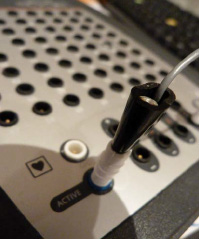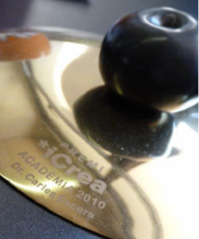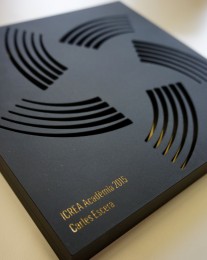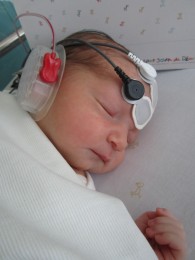I graduated in Psychology at the University of Barcelona in 1987, and after completing my PhD with the thesis “Ultradian rhythms in human brain function during wakefulness: event-related brain potentials and behavior” in 1993, I had an atypical [scattered over a few years due to my teaching obligations] postdoctoral experience in Risto Näätänen’s laboratory at the University of Helsinki (1993, 1994, 1996, 1999). There I learned about the cerebral mechanisms of selective and involuntary auditory attention, as investigated with event-related brain potentials (ERPs). Good old times where I met some very good friends with whom I still have ongoing collaboration (Kimmo Alho, Erich Schröger, Istvàn Winkler, Hirooki Yabe).
 My research has focused on three separated but closely related research areas. First, we devised an experimental task to investigate the cerebral mechanisms of involuntary attention. In short, participants have to classify visual stimuli pertaining to two different categories, while ignoring concomitant (preceding!) task-irrelevant sounds. These latter, when deviant or novel, increased response time in the primary visual task, i.e., caused behavioral distraction and elicited a typical pattern in the ERPs, characterized by the mismatch negativity (MMN), a bi-phasic novelty-P3 and the Reorienting Negativity (RON)(Escera, Alho, Winkler, Näätänen, 1998). Subsequent studies manipulated distracter features, irrelevant stimulus-main task contingencies, stimulus significance, emotional context or working memory load, and were applied to investigate involuntary attention deficits in a range of clinical conditions. The major outcome of this research was that involuntary attention is modulated by top-down factors (Escera and Corral, 2007).
My research has focused on three separated but closely related research areas. First, we devised an experimental task to investigate the cerebral mechanisms of involuntary attention. In short, participants have to classify visual stimuli pertaining to two different categories, while ignoring concomitant (preceding!) task-irrelevant sounds. These latter, when deviant or novel, increased response time in the primary visual task, i.e., caused behavioral distraction and elicited a typical pattern in the ERPs, characterized by the mismatch negativity (MMN), a bi-phasic novelty-P3 and the Reorienting Negativity (RON)(Escera, Alho, Winkler, Näätänen, 1998). Subsequent studies manipulated distracter features, irrelevant stimulus-main task contingencies, stimulus significance, emotional context or working memory load, and were applied to investigate involuntary attention deficits in a range of clinical conditions. The major outcome of this research was that involuntary attention is modulated by top-down factors (Escera and Corral, 2007).
 On a parallel account, we devoted research to improve the usability of the MMN as an objective index of auditory discrimination deficits in a range of neurological, psychiatric and neurodevelopmental disorders. The MMN is elicited when the current stimulus does not match a neural representation of the preceding acoustic regularity, and as such, can index central sound representation and auditory discrimination, as well as the encoding of regularities to stimulus repetition, and prediction error to mismatching stimuli. For instance, we found that persistent developmental stutterers display abnormal representation of the sounds of language (Corbera et al., 2005). Together with Risto Näätänen, and other colleagues, we have published a series of review papers on the clinical applications of the MMN (Näätänen and Escera, 2000; Näätänen et al., 2011; Näätänen et al., 2012).
On a parallel account, we devoted research to improve the usability of the MMN as an objective index of auditory discrimination deficits in a range of neurological, psychiatric and neurodevelopmental disorders. The MMN is elicited when the current stimulus does not match a neural representation of the preceding acoustic regularity, and as such, can index central sound representation and auditory discrimination, as well as the encoding of regularities to stimulus repetition, and prediction error to mismatching stimuli. For instance, we found that persistent developmental stutterers display abnormal representation of the sounds of language (Corbera et al., 2005). Together with Risto Näätänen, and other colleagues, we have published a series of review papers on the clinical applications of the MMN (Näätänen and Escera, 2000; Näätänen et al., 2011; Näätänen et al., 2012).
 More recently, and departing from the observation that certain neurons in the primary auditory cortex, the auditory thalamus or the inferior colliculus exhibit stimulus-specific adaptation (SSA), i.e., restore their firing rate to a deviant stimulus in a manner comparable to the MMN behavior, my recent research has suggested that deviance detection based on regularity encoding in a key principle of the functional organization of the auditory system. We recorded middle-latency (MLR) and complex auditory brainstem (cABR) response or run MEG or fMRI experiments to find deviance-related responses at latency ranges and anatomical level of those of the neurons exhibit SSA (Escera and Malmierca, 2014; Escera et al., 2013). This research benefited considerably for the collaborative ERANET-NEURON project from the Seventh Framework of the EU entitled “Probing the Auditory Novelty System”, which gathered together researchers from Spain (Manuel S. Malmierca), Israel (Israel Nelken) and Finalnd (Minna Huotilainen) under my coordination.
More recently, and departing from the observation that certain neurons in the primary auditory cortex, the auditory thalamus or the inferior colliculus exhibit stimulus-specific adaptation (SSA), i.e., restore their firing rate to a deviant stimulus in a manner comparable to the MMN behavior, my recent research has suggested that deviance detection based on regularity encoding in a key principle of the functional organization of the auditory system. We recorded middle-latency (MLR) and complex auditory brainstem (cABR) response or run MEG or fMRI experiments to find deviance-related responses at latency ranges and anatomical level of those of the neurons exhibit SSA (Escera and Malmierca, 2014; Escera et al., 2013). This research benefited considerably for the collaborative ERANET-NEURON project from the Seventh Framework of the EU entitled “Probing the Auditory Novelty System”, which gathered together researchers from Spain (Manuel S. Malmierca), Israel (Israel Nelken) and Finalnd (Minna Huotilainen) under my coordination.
 Currently, I am fascinated by a minute brain potential known as the Frequency-Following Response (FFR). The FFR captures with great fidelity the tracking accuracy of periodic sound features in the auditory midbrain and thalamus, so that one can read subcortical neural traces from the human scalp as sounds are transcribed in subcortical neuronal aggregates, and how these soundtraces are shaped by experience and context (see Escera, 2017). Using the FFR, I have managed to show subcortical prediction errors (Slabu et al., 2012), the involvement of the serotonin transporter gen in accurate subcortical speech encoding (Selinger et al., 2016) and that timing predictability enhances subcortical regularity encoding (Gorina-Careta et al., 2016). My current research program, carried out at the Institut de Recerca Sant Joan de Déu, aims at characterizin by means of the FFR, the encoding of speech sounds in neonates and infants and whether defective neuronal speech encoding can predict neurocognitive impairment.
Currently, I am fascinated by a minute brain potential known as the Frequency-Following Response (FFR). The FFR captures with great fidelity the tracking accuracy of periodic sound features in the auditory midbrain and thalamus, so that one can read subcortical neural traces from the human scalp as sounds are transcribed in subcortical neuronal aggregates, and how these soundtraces are shaped by experience and context (see Escera, 2017). Using the FFR, I have managed to show subcortical prediction errors (Slabu et al., 2012), the involvement of the serotonin transporter gen in accurate subcortical speech encoding (Selinger et al., 2016) and that timing predictability enhances subcortical regularity encoding (Gorina-Careta et al., 2016). My current research program, carried out at the Institut de Recerca Sant Joan de Déu, aims at characterizin by means of the FFR, the encoding of speech sounds in neonates and infants and whether defective neuronal speech encoding can predict neurocognitive impairment.
On Academy side, I am member of the Academia Europeae and the Principal Investigator of the Brainlab-Cognitive Neuroscience Research Group (since 2003), I coordinated the Spanish Network in Cognitive Neuroscience (2008-2010), I was the director of the former Institute for Brain Cognition and Behavior (IR3C) of the University of Barcelona (2009-2015), I was the director of the Institue of Neurosciences of our university (2016-2017), and I have received the ICREA Academia Distinguished Professorship three time, in 2010, 2015 and 2020.
My full CV is here.

